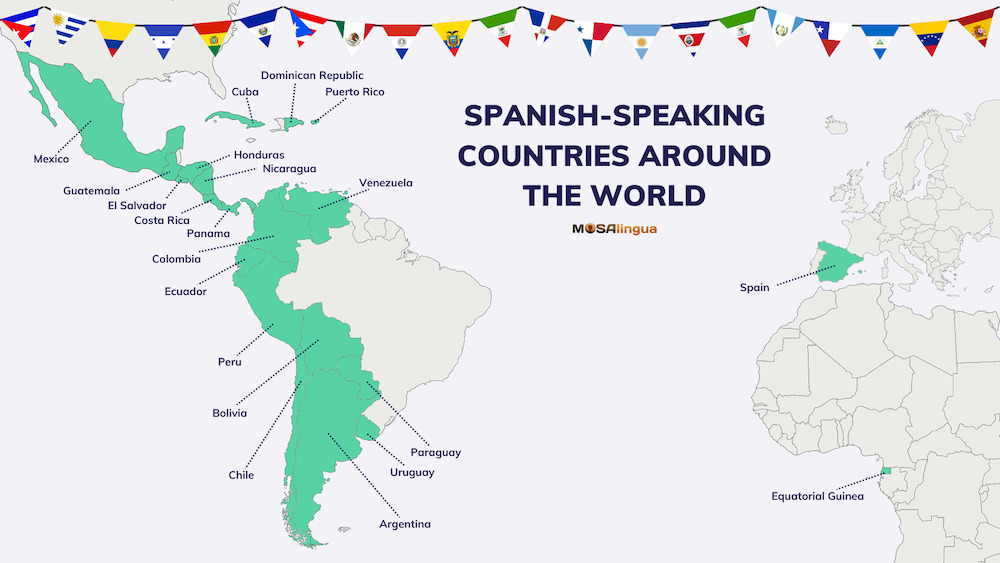Spanish can be a complex language. Not because of its difficulty, but because of its variety! This language is officially spoken in 21 countries across the globe, mostly in Latin America. However, all 21 countries don’t speak the same Spanish. In fact, there are many different dialects of Spanish spoken within each country! Spanish is a beautiful and diverse language, and if you’re thinking about learning it, you might be asking yourself—what is the best Spanish accent to learn?
In this article, we’ll look at the differences between the most common dialects of Spanish to try to answer this question. ¡Vamos!
Last actualization 10/3/2024
What is the Best Spanish Accent to Learn?
To determine which the best Spanish accent to learn is, we first need to learn a little more about the types of Spanish accents. Spanish is spoken as an official language in 21 countries in Europe and Latin America, so there are many varieties of Spanish spoken throughout the world. Here are the countries where Spanish is spoken as an official or colloquial language:
Let’s learn a little more about why these countries all speak different varieties of Spanish.
One Language, Many Accents
You might already know that there is a difference between the Spanish spoken in Spain and the Spanish spoken in Latin America. That’s not so surprising; after all, they’re separated by a huge ocean. But there are also differences in the Spanish spoken throughout Latin America; often, within the same countries!
But why do all these countries speak a different kind of Spanish?
When the colonials arrived in Latin America, they brought their language with them, which was still developing in Spain. Spanish was still evolving in its country of origin, but it was also doing so within the colonies of Latin America. This created a lag—Marckwardt coined the term “colonial lag” to describe this phenomenon— between the language spoken in colonies and the evolution of Spanish in its country of origin, Spain.
The Spanish spoken in Spain, as well as the Spanish spoken in each different part of Latin America, all developed unique grammar structures, vocabulary, phonology (aka the system of sounds within a language), and more. Now let’s talk about these language differences!
What are the differences between the different types of Spanish accents?
Spanish is an incredibly rich language, and in reality, probably has thousands of dialects and accents. Since we don’t want to keep you here all day, we’ll explore some of the most common Spanish accents below.
Spain
Many people consider the Castilian accent the easiest Spanish accent for learners to understand because of its clear pronunciation. Castilian Spanish is the dialect spoken in Spain’s capital and throughout central and northern Spain. In this dialect of Spanish, you’ll find the famous ceceo! This is sometimes called the Spanish lisp, but Spaniards don’t appreciate that. The ceceo is just a particular pronunciation of the letter “z” and the “ci”/”ce” combination as we do with the English “th” (as in “thanks”). The same goes for words that end in the letter “d”.
Another characteristic of Castilian Spanish is its use of vosotros, the informal form of ustedes. Vosotros is ONLY used in Spain—it is not found in any other Spanish-speaking population.
Rioplatense Spanish: Argentina, Uruguay and Paraguay
In most Spanish-speaking places, the second-person informal pronoun used is tú is used. But in Argentina, Paraguay, and Uruguay, they instead use vos as a second-person informal pronoun. They also conjugate the corresponding present-tense second-person form of verbs slightly differently (tenés instead of tienes is an example).
This is similar to the English word thou, which seems extra formal and archaic to English speakers, but was the informal form, whereas you was the formal form.
In Argentina, they also famously pronounce the Spanish double-l sound, which normally sounds like a soft “y” sound (as in “yes”), with a “sh” sound instead (as in “shake”). That means that in Argentina, llover would be pronounced like shover. And yo me llamo becomes sho me shamo (only in pronunciation, of course, not in spelling!).
Mexico
Mexican Spanish is easily recognizable because of how it marks a tone at the end of the last word of every phrase (a bit – but not exactly – like when asking a question), and because of how it reduces accentuation on certain vowels. Mexican accents are more melodious than forms of Castilian Spanish and are fairly easy to learn. In what is considered standard pronunciation in Mexico, “s” becomes “z” before a voiced consonant (e.g. “es lo peor” becomes “ezlo peor”).
Mexican Spanish also has TONS of slang words that aren’t found in other countries. It’s a truly colorful dialect!
Colombia
There are many accents within Colombia (just as there are many accents within Mexico, Argentina, etc…). However, in general, the Colombian accent is known for being relatively neutral, and in particular the accent from Bogotá. It is a very understandable accent even for those from other countries (telenovelas have probably contributed to this).
Rolos (people who live in Bogotá) tend to speak a little more slowly and clearly, enunciating every vowel. Since most people from Spanish-speaking countries can understand it easily, it’s a good accent to choose.
Caribeño Spanish: Cuba, Puerto Rico, Dominican Republic
Caribeño Spanish, spoken by people in the Caribbean, has many distinct characteristics that make it special. For instance, in Caribeño Spanish, the “r” is often pronounced as an “l” when at the end of a word (amor becomes amol). And sometimes, both the “r” and the “s” are aspirated, giving something close to an “h” (largo becomes lahgo).
There’s also the disappearing “d”, where speakers of Caribeño Spanish don’t pronounce the letter “d” when it appears between two vowels. As a result, many past participles get shortened: enamorado becomes enamora’o, cansado becomes cansa’o.
Oh yeah, and Caribeño Spanish speakers speak FAST. All those dropped letters are the result of Spanish being rattled off at the speed of light. Spanish speakers from other countries can even have a hard time understanding Caribeño Spanish!
Bonus Video
No time to read? In this video, Mirari breaks down some of the most common Spanish accents and shares details about them. Check it out!
So, Which is the Best Spanish Accent for You to Speak?
We can’t answer this question for you, but here are three questions to help you decide:
-
Where do you live?
The differences between Spanish accents might not seem that important if you don’t live in a place close to a Spanish-speaking country. But maybe you live in Texas or New Mexico and you meet lots of Mexicans: it might be a good idea to learn Mexican Spanish. Or maybe you live in Portugal, so it makes sense for you to learn Castilian Spanish.
-
Which one do you think will be the most useful to you?
Are you going to study in Spain for a few years? Is your future spouse originally from Paraguay? Are there many Colombians in your neighborhood? Choose accordingly.
-
Which Hispanic culture interests you the most?
Since Spanish is spoken in such a wide variety of places, it’s connected to many different and unique cultures. Maybe you love the movies of Nuevo Cine Mexicano, or your favorite cuisine is Peruvian food, or you listen to a lot of rock music from Spain. Choose the Spanish accent that allows you to enjoy your interests and have fun. After all, the best way to stay motivated when learning a language is to enjoy it!
We hope this has been a useful guide to the best Spanish accents. When it comes to picking the Spanish accent you want to learn, don’t stress too much. Whichever accent you choose, you will be understood wherever you go. And remember to have fun!
If you liked this article, go further:
- Latin America vs. Spain: Which Spanish Should I Learn?
- Learn How to Recognize Different Spanish Accents
- Spanish-Speaking Countries: Can You Name Them All?
Related posts:
Want to start improving your language skills today?
Improve your spoken Spanish

Good news: we have a course for that! The Speak Spanish with Confidence MasterClass.
It’s a comprehensive 8-module course designed to help you improve every aspect of your spoken Spanish – fluency, confidence, pronunciation, and more – step by step, and enjoy doing it.









Very interesting article about Spanish and Latin-American accents!
In recent years (2019 to 2022) I was taking intermediate-level Spanish courses at Central Technical school in Toronto. Our teacher, a native of the city of Medellin, Colombia, near the Andes mountains. In her part of Latin America, people don’t speak Spanish too fast – they speak it slower. Maybe it has to do with the lifestyle of the Andes; it’s slower paced, not so rat-race.
This slower-paced Andean Spanish made the lessons easier for the students to follow and take in.
One thing that surprised us students taking these Spanish courses is when it came to conjugating verbs, the “vosotros” (plural of “tu”) form was included.
It’s believed that the Colombian accent and dialect is among the purest.
Enjoyed the article and subsequent debate! My girlfriend is Bolivian and they use the vos form for people extremely close them. Unsurprisingly, it is more common in the Eastern parts closer to Argentina.
Also I think you mean pejorative (insulting) instead of prerogative (right) 🙂
Hi James.
I’m glad you enjoyed both the articles and comments 🙂
It is interesting how words can be understood and used so differently in different cultures!
You’re right about pejorative. Thanks for pointing it out!
We’ve changed this.
Hello,
I am a Spaniard plus Spanish teacher for several years (specialized in Linguistics). Totally agree with the two comments above. In Spain we talked about “castellano” and never “español”, Rubén explained pretty well the reason why. It is really ridiculous that Mosalingua answers to his comment with a simple “we really appreciate when users point out mistakes, even if we do not agree with you. As it is from our experience, generally, Spaniards refer to their language more as “Español” while LATAM speakers mostly choose “Castellano”.”
It is not about agreeing, is about facts. I am a native Spanish, who lived in different cities in Spain and I am in contact with teachers and not teachers around Spain. That is my first hand experience. I also known center and south american who told me their refr to “castellano” as well. Could you please specify where did you get your experience from?
Thanks for your input.
We do have 3 Spanish persons in our team and 2 from LATAM we asked before replying to the last comments, so we are fairly certain the article is correct.
However, we understand that this is a controversial topic.
It is our position and understanding that in Spain both terms might be used, although, and this does depend on who you ask, they say Castellano when talking with Spaniards (for example, at school, the Lengua Castellana is studied) and español when talking with people from LATAM or other countries.
Here is what two academies have to say about this:
According to the RAE (Real Academia Española) we can use both terms in Spain:
“Para designar la lengua común de España y de muchas naciones de América,… son válidos los términos castellano y español.”
Which translates as “To design the common language of Spain and many nations in America… castellano and expañol are valid”.
A LATAM academy, The Academia de las Lenguas de Argentina, says:
En el uso general las denominaciones «castellano» y «español» son equivalentes.”
Which means “Generally, the denominations ‘castellano’ and ‘español’ are the same”
It then goes on to say how the former is better to refer to the dialect from Castilla, and the latter to mean the language spoken by all countries.
Nonetheless, and as mentioned above, this is somewhat controversial, so we understand the messages we’ve received about this 🙂
Thanks again for your input!
I’d agree with what Ruben said in that please take this article with a grain of salt. This article seems to be skewed a bit toward Argentines in my opinion. I’ve really only heard Spanish being referred to as Castellano in Argentina and Uruguay and in certain parts of Spain, but I haven’t heard it anywhere else in Latin America.
As well, “vos” is not the formal version of you. That would be “usted.” Vos is the exact same as tú in terms of context, obviously with vos you conjugate verbs differently (although it’s much easier in my opinion). Context for using vos/tú versus usted all depends on the country. Argentina, for example, you would never use usted. However, in Cali in Colombia, for example, you only use usted. It all depends on the region.
Also, I would probably specify that the MosaLingua app uses the accent from Bogotá. While all Spanish speaking countries have a multitude of accents, I would note that Colombia has an even more diverse array of accents in my opinion. The accent in Bogotá is quite different from the accent in Medellín or Cali for example.
Another picky detail, is I would say the “y” sound is not used in all countries but Argentina/Uruguay. Yes, Argentina and Uruguay are the only countries to use the “sh” sound, but not all other countries use the “y” sound. In Chile, for example, they often use a “zh” sound (although I would not recommend learning Spanish in Chile as our accent is a bit of an anomaly). Many areas of Colombia and Venezuela use a “j” sound instead. Again, the y and ll are all dependent on the region.
I also don’t think I would refer to Colombian Spanish as “the most beautiful” since that is all dependent on who you ask. Most Colombians definitely have a very clear Spanish, but that means it’s easy to understand, not necessarily the “most beautiful.” Personally, I think the three countries with the clearest accents are Colombia, Ecuador, and Venezuela. If you talk about the most beautiful accents, I’m obligated to say my accent, the Chilean accent, is the most beautiful (but every other Spanish speaker outside of Chile would say ours is the worst), but I also love the Cuban and Dominican accents.
Just some nit picky details. I apologize if I have any mistakes in here. English is my third language (after Spanish and Portuguese), and I’m still learning it (as I’m Chilean but recently moved to USA for university).
Hello,
Thank you for your input on this.
Here’s our answer point by point:
– The article does talk a lot about the Argentinian accent. Mathilde, who is the author of the article, was mostly writing from her experience. We don’t think it’s something that should be changed
– A quick search on the internet shows that Castellano is used in more than these two countries. Here’s an example https://moverdb.com/castellano-vs-espanol/
– We have rectified the information about the use of voseos. Thank you for pointing this out.
– According to Wikipedia’s article on voseo, the geographical distribution can be split into three categories:
Countries where voseo is predominant:
Argentina, Paraguay, Uruguay, El Salvador, Guatemala, Honduras, Nicaragua, Costa Rica
Countries where both forms are used:
Bolivia, Chile, Colombia, Ecuador, Panama, Venezuela
Countries where vos is practically out of use:
Spain, Dominican Republic, Puerto Rico, Mexico, Peru, Cuba
– We’ve also changed the information on which specific accent we use in the app. Well spotted: we used Bogota accent because it’s the most neutral version and after studying a lot about the subject it seems one of the easiest accent to understand overall in the whole world.
– For the Y sound, we only gave Argentinian as an example, we never said this is the only variation.
– Yes, the word beautiful is very subjective to a person’s tastes.. That’s why we gave our reason as to why we said this. We don’t think it should be out though, as whenever anyone someone says something is beautiful, it’s implied that it is that person’s point of view. If not, you would never be able to use that word 🙂
Thank you again for pointing these things out, and well done for your English!
So much wrong with this article. Please don’t take it seriously becuase it just extremely superficially explains some differences withim the Spanish language and most of them are not even explained correctly.
E.g. in Spain it is called “Castellano” not español. This should be quite obvious for anyone interested in the language since “Castellano” refers to the language of the main, biggest and politically (in the past) most important provinces of Spain: “Castilly y Leon” and “Castille la Mancha”.
There are many more errors in this article so please take it with a grain of salt.
Hello,
Thanks for your comment – we really appreciate when users point out mistakes, even if we do not agree with you. As it is from our experience, generally, Spaniards refer to their language more as “Español” while LATAM speakers mostly choose “Castellano”.
As for any other mistakes, do let us know, and we’ll be happy to change them!
Thanks again for your message!
Being a Spanish speaker myself from Venezuela (that has lived in Spain for over a decade) I can’t stress on how important the points Mathilde touches on truly are if you wish to learn Spanish properly.
Chances are a lot of people trying to learn the language become scared or confused by the fact Spanish itself is a very dynamic. The language has been shaped in different ways that can be pinpointed to a specific region’s culture and influences.
Though some words may differ, pronounciation remains mostly the same across the different Spanish speaking countries. This makes the good use of punctuation, sentence structure, and grammatical rules all that more important regardless of your motivation to learn the language.
Over at MyDailySpanish we’ve created an article that compliments this and digs further into some of these points (punctuation, sentence structure, phonetics), and provides some tips to reinforce the fundamentals and improve pronounciation.
Learners shouldn’t refrain from learning to use the different Spanish accents, after all it comes down to a personal choice or the situation you find yourself in.
I would dare to say that even most of us native Spanish speakers have a rough time understanding our own people at times. Let’s not forget there can be different accents not only across the countries that speak Spanish, but across regions, states, and cities of the same country as well!